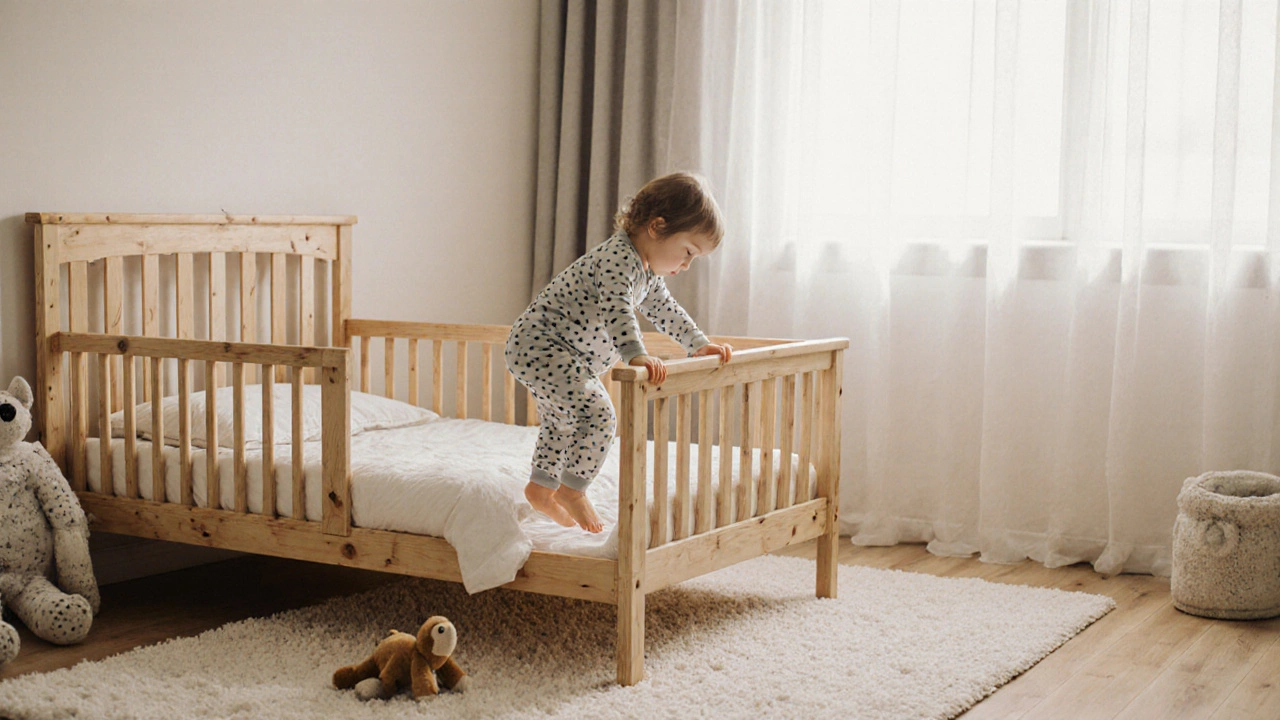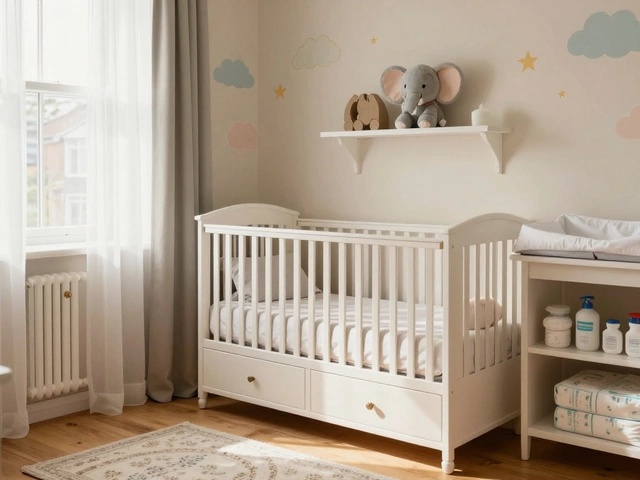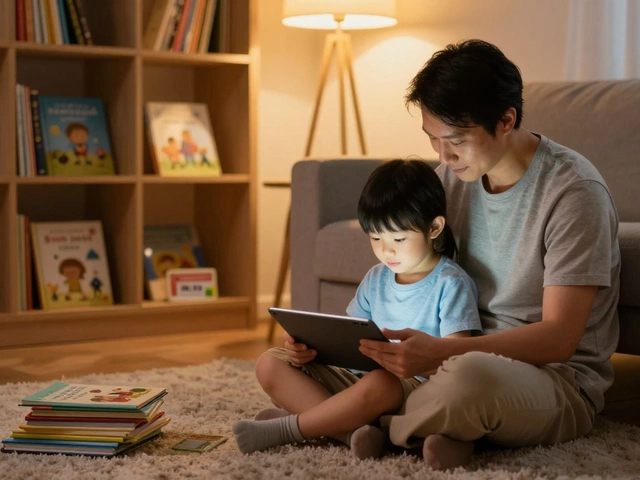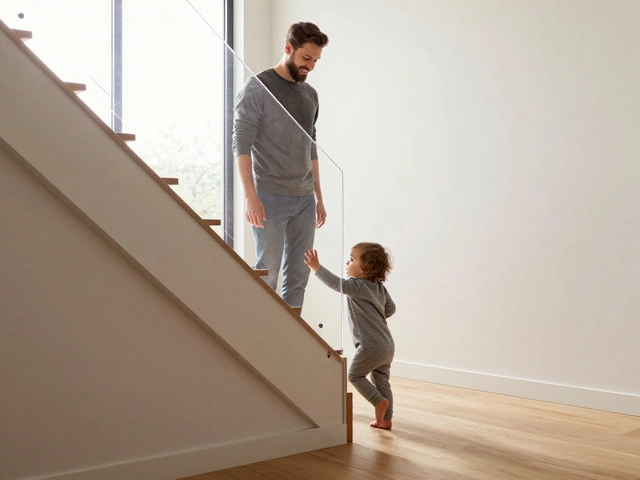
When your 3-year-old starts climbing out of the crib, you know it’s time for a new bed. But not just any bed will do. A toddler bed isn’t just a smaller version of a grown-up bed-it’s a safety-first, size-perfect, sleep-supporting step in your child’s development. Choosing the right one can mean fewer midnight falls, less stress at bedtime, and more rest for everyone.
Why a Toddler Bed Instead of a Regular Bed?
At three, your child is growing fast-physically and emotionally. They’re learning independence, testing boundaries, and maybe even having their first big fears. A toddler bed bridges the gap between the enclosed safety of a crib and the open freedom of a full-size bed. Most toddler beds sit low to the ground, usually under 6 inches high. That means if they roll out, they’re not falling from a height. A fall from a standard bed can mean a trip to the ER. A fall from a toddler bed? Usually just a startled cry and a hug.
Also, toddler beds are designed to fit standard crib mattresses. That’s a big win. You don’t need to buy a new mattress. Just swap the crib for the bed frame, and you’re done. It’s familiar, it’s safe, and it’s cost-effective.
What to Look for in a Toddler Bed
Not all toddler beds are created equal. Here’s what actually matters:
- Low height-Ideally under 6 inches from the floor. Some models are even lower, around 3 inches. The lower, the safer.
- Guardrails-Built-in or attachable. Look for ones that are securely fastened and don’t have gaps wider than 2.5 inches (to prevent head entrapment).
- Sturdy frame-Solid wood or thick metal. Avoid flimsy plastic or wobbly joints. If it shakes when you push it, it’s not safe.
- Non-toxic finishes-Check for certifications like JPMA (Juvenile Products Manufacturers Association) or EN71 (European safety standard). Avoid beds with strong chemical smells.
- Easy access-A bed with an open side or a removable rail helps kids get in and out on their own. That builds confidence and reduces bedtime battles.
Some beds come with fun themes-dinosaurs, princesses, race cars. That’s great for motivation, but don’t let the design override safety. A bed that looks like a castle is useless if the rails can’t hold up to a 30-pound toddler’s midnight sprint.
Best Toddler Beds of 2025
Based on real parent feedback, safety ratings, and durability testing, these are the top three toddler beds you can trust right now:
| Model | Height from Floor | Weight Capacity | Material | Key Feature |
|---|---|---|---|---|
| Graco Pack ‘n Play Playard Bed | 4 inches | 50 lbs | Steel frame, fabric sides | Converts from playard to bed-great for small spaces |
| Delta Children Toddler Bed | 5 inches | 50 lbs | Solid pine wood | Low-profile, no assembly required, 5-year warranty |
| Dream On Me Convertible Toddler Bed | 6 inches | 50 lbs | Engineered wood, non-toxic finish | Converts to daybed-grows with your child |
The Graco is ideal if you’re short on space or still using the playard for naps. The Delta Children model is the most popular among UK parents for its simplicity and durability. The Dream On Me is the best if you want to avoid buying another bed in a couple of years.

What to Avoid
Not every bed marketed as "toddler-friendly" is actually safe. Watch out for:
- High beds with no guardrails-Even if it’s labeled "toddler," if it’s higher than 6 inches and has no side protection, it’s a risk.
- Bed frames with decorative cutouts-Those heart-shaped or star-shaped holes? They can trap limbs or heads. Avoid them.
- Secondhand beds without manuals-If you can’t find the original assembly instructions or safety warnings, don’t risk it. Parts can be missing or worn.
- Bedding that’s too big or fluffy-Pillows, thick blankets, and stuffed animals in the bed? Not for 3-year-olds. The American Academy of Pediatrics still recommends no soft bedding until age 2, and many experts say wait until 3.5-4 to be safe.
A 2024 study by the UK’s Child Accident Prevention Trust found that 42% of toddler bed injuries occurred from falls due to missing or loose guardrails. That’s not a small number. It’s a warning.
How to Make the Transition Smooth
Moving from crib to bed isn’t just about buying the right product-it’s about changing the routine. Here’s how to make it work:
- Wait for signs-Climbing out, waking up cranky from crib falls, or asking for a "big kid bed" are good indicators. Don’t rush it.
- Let them help-Take them shopping. Let them pick the sheet or a small stuffed animal for the bed. Ownership reduces anxiety.
- Use a gate or baby gate at the bedroom door-Some kids will get up and wander. A gate keeps them safe until they learn bedtime rules.
- Keep the same bedtime routine-Story, song, hug, light off. Familiarity helps them feel secure.
- Don’t panic if they get up-It’s normal. Gently guide them back, say "it’s sleep time," and leave. Don’t make it a negotiation.
One mum from Bristol told me her son started getting up 12 times a night. She used a simple reward chart-five quiet nights, one new book. Within two weeks, he was sleeping through. Small wins matter.
When to Skip the Toddler Bed
Not every family needs a toddler bed. If your child is tall, active, or already sleeps well on a mattress on the floor, you might skip it. Many parents in the UK are going straight from crib to a floor bed-a low, firm mattress placed directly on the floor, often with a safety rail on one side.
It’s cheaper, safer, and gives your child total freedom to get in and out. You just need to childproof the room thoroughly-cover electrical outlets, secure furniture to walls, remove small objects. But if you’re up for the extra prep, it’s a great option.
Another alternative? A low-profile twin bed with a guardrail on one or two sides. Many parents find this works just as well, especially if they plan to keep the bed for years.

Final Checklist Before You Buy
Before you hand over your card, run through this quick list:
- Is the bed under 6 inches high?
- Are the guardrails secure and gap-free?
- Is the frame made of solid wood or thick metal?
- Does it use a standard crib mattress?
- Is it certified by JPMA or EN71?
- Does it come with a warranty?
- Can I assemble it myself in under an hour?
If you answered yes to all of those, you’ve got a winner.
What About Mattresses?
You’re probably still using the crib mattress. That’s fine-most toddler beds are designed for it. But if you’re replacing it, look for a firm, non-toxic, breathable mattress. Avoid memory foam. It’s too soft for a 3-year-old and can trap heat. A firm innerspring or high-density foam mattress is best. Brands like Newton Baby and My Green Mattress offer non-toxic, washable options that parents trust.
Remember: firmness is safety. A mattress that sinks too much increases the risk of suffocation-even if your child is past the newborn stage.
Can a 3-year-old sleep in a twin bed?
Yes, but only if it’s low to the ground and has guardrails on at least two sides. A standard twin bed is about 18 inches high-that’s too tall for a 3-year-old without protection. Use a toddler rail or place the bed against a wall with a sturdy guard on the open side. Many parents start with a twin bed and remove the rail later when the child is 5 or 6.
Is a bunk bed okay for a 3-year-old?
No. The Consumer Product Safety Commission advises against children under 6 sleeping on the top bunk. Even the bottom bunk can be risky if there’s no guardrail or if the bed is unstable. Stick to low, ground-level beds until your child is at least 5.
Should I use a pillow for my 3-year-old?
Wait until your child is at least 3.5 to 4 years old. Before then, pillows can increase suffocation risk and interfere with proper spinal alignment. If you do introduce one, choose a thin, firm, hypoallergenic pillow-never a fluffy, oversized one.
How do I know if my toddler is ready for a bed?
Look for these signs: climbing out of the crib regularly, showing interest in a "big kid bed," or waking up upset after falling out. Most kids are ready between 2.5 and 3.5 years old. Don’t force it if they’re still happy in the crib-there’s no rush.
What if my child keeps getting out of bed?
It’s normal. Use a baby gate at the bedroom door to keep them safe while they learn the rules. Stay calm, gently return them to bed, and repeat. Avoid making it a game. Consistency and quiet reinforcement work better than punishment. Most kids adjust within 1-2 weeks.
Next Steps
Start by measuring your nursery space. Know your mattress size. Check safety ratings online. Then visit a local store if you can-let your child touch the frame, sit on it, see how it looks. If you’re buying online, choose a retailer with free returns. You might need to swap it out if it’s too high or too noisy.
And remember: the best bed isn’t the fanciest or the cheapest. It’s the one that keeps your child safe, helps them sleep, and gives you peace of mind. That’s worth more than any discount.






